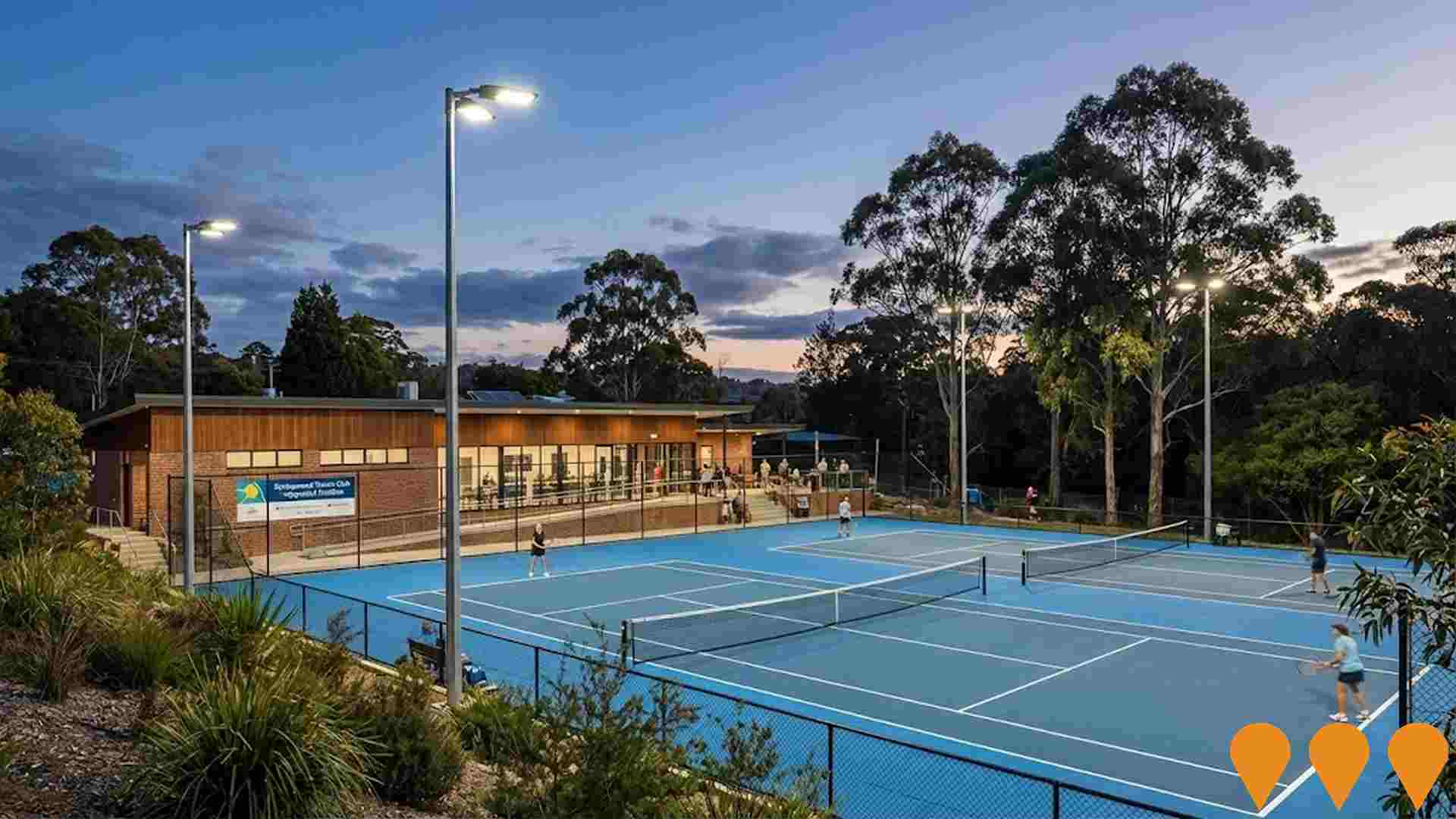Chart Color Schemes
est. as @ -- *
ABS ERP | -- people | --
2021 Census | -- people
Sales Activity
Curious about local property values? Filter the chart to assess the volume and appreciation (including resales) trends and regional comparisons, or scroll to the map below view this information at an individual property level.
Find a Recent Sale
Sales Detail
Population
Springwood - Winmalee has shown very soft population growth performance across periods assessed by AreaSearch
Springwood-Winmalee's population was 21,964 as of the 2021 Census. By Nov 2025, it is estimated to be around 22,183, reflecting an increase of 219 people (1.0%) since the Census. This change is inferred from ABS estimates: 22,137 in June 2024 and additional validated new addresses since the Census date. The population density as of Nov 2025 is approximately 318 persons per square kilometer. Springwood-Winmalee's growth rate of 1.0% since the census is within 0.2 percentage points of its SA3 area's growth (1.2%), indicating competitive fundamentals. Overseas migration contributed around 96.6% to recent population gains in the area.
AreaSearch uses ABS/Geoscience Australia projections for each SA2 area, released in 2024 with a base year of 2022. For areas not covered by this data, NSW State Government's SA2 level projections are used, released in 2022 with a base year of 2021. Growth rates by age group from these aggregations are applied to all areas for years 2032 to 2041. By 2041, the area's population is projected to decline by 330 persons overall, but specific age cohorts like those aged 85 and over are expected to grow, with a projection of an increase of 838 people in this group.
Frequently Asked Questions - Population
Development
AreaSearch assessment of residential development drivers sees a low level of activity in Springwood - Winmalee, placing the area among the bottom 25% of areas assessed nationally
Springwood-Winmalee averaged approximately 27 new dwelling approvals per year over recent years. A total of 138 homes were approved between the financial years FY-21 and FY-25, with an additional 5 approved so far in FY-26. The average construction value for these dwellings is around $340,000.
In terms of commercial development, $21.5 million worth of approvals have been recorded this financial year. Compared to Greater Sydney, Springwood-Winmalee shows approximately 62% of the construction activity per person, placing it among the 16th percentile nationally in terms of choices for buyers. The area's new building activity is dominated by detached houses, with an estimated 86.0%, while townhouses or apartments make up around 14.0%. This results in a low-density environment, attracting space-seeking buyers.
The population per dwelling approval in the area is estimated at 1092 people. Population projections suggest stability or decline, which may reduce housing demand pressures and benefit potential buyers.
Frequently Asked Questions - Development
Infrastructure
Springwood - Winmalee has strong levels of nearby infrastructure activity, ranking in the top 40% nationally
Changes to local infrastructure significantly influence an area's performance. AreaSearch has identified six projects expected to impact the area. Notable projects include Woolworths Springwood Supermarket, Rail Infrastructure Upgrades - Springwood Station, Springwood District Library Redevelopment, and Springwood Tennis Club Upgrade. The following list details those most likely relevant.
Professional plan users can use the search below to filter and access additional projects.
INFRASTRUCTURE SEARCH
 Denotes AI-based impression for illustrative purposes only, not to be taken as definitive under any circumstances. Please follow links and conduct other investigations from the project's source for actual imagery. Developers and project owners wishing us to use original imagery please Contact Us and we will do so.
Denotes AI-based impression for illustrative purposes only, not to be taken as definitive under any circumstances. Please follow links and conduct other investigations from the project's source for actual imagery. Developers and project owners wishing us to use original imagery please Contact Us and we will do so.
Frequently Asked Questions - Infrastructure
Western Sydney International (Nancy-Bird Walton) Airport
New 24-hour international airport at Badgerys Creek, Western Sydney. Major construction of runway, terminal and supporting infrastructure is nearing completion. The airport remains on schedule to open to passenger flights in late 2026. Stage 1 includes a single 3,700 m runway, a terminal designed by Zaha Hadid Architects and COX Architecture (built by Multiplex), cargo facilities, and an on-airport business park. Initial capacity is 10 million passengers per year, ultimately expandable to 82 million. The project is expected to support 28,000 jobs by the early 2030s and more than 200,000 jobs over the longer term.
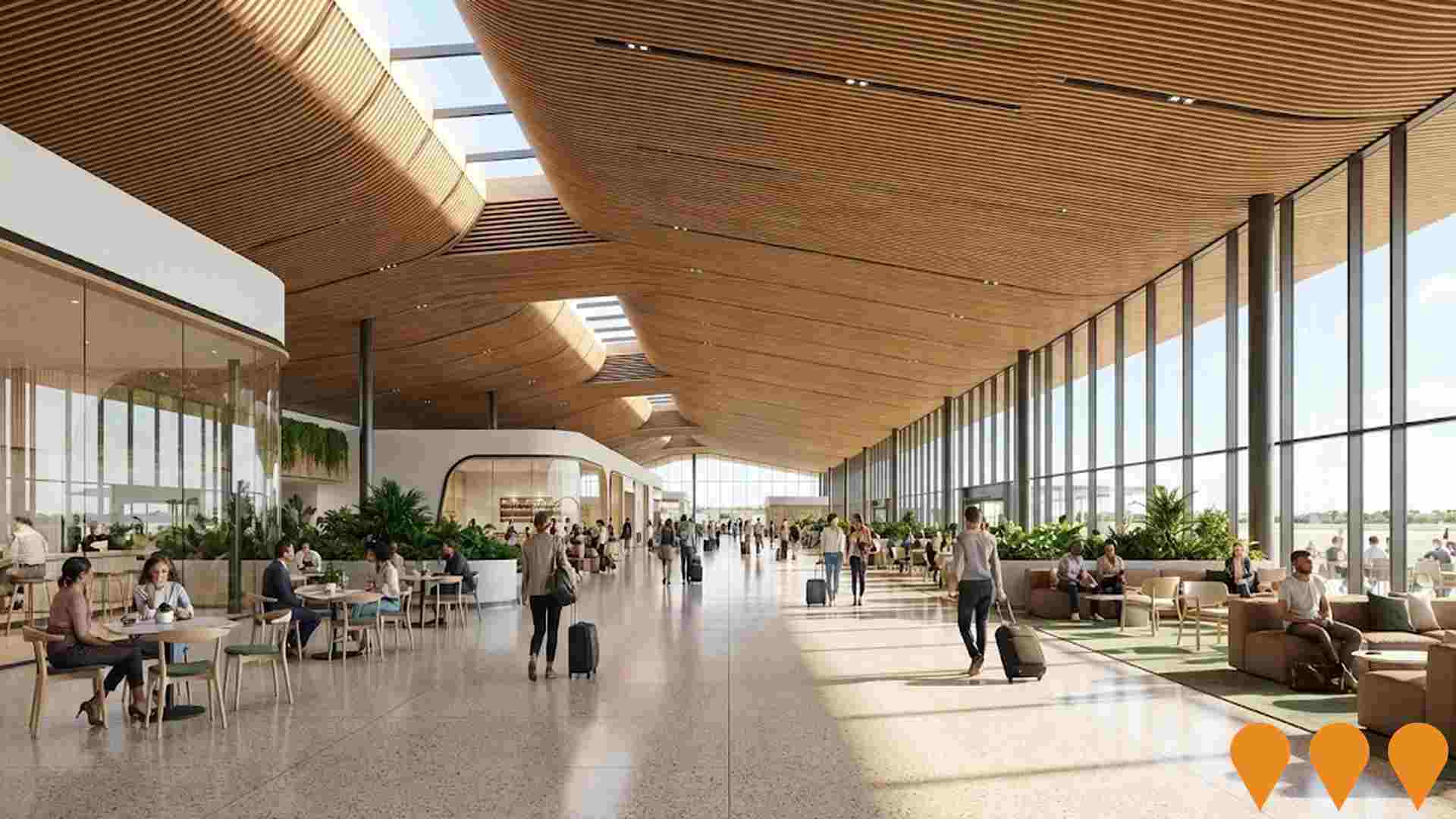
Westfield Penrith Entertainment Expansion
$33 million expansion by Scentre Group to create a leading entertainment and leisure precinct. Features new three-level dining precinct, upgraded Hoyts cinema with two new Lux Cinema auditoriums, reconfigured Riley Street entrance with illuminous light panels, Archie Brothers Cirque Electriq, Holey Moley golf, and a new Coles supermarket. Completed in 2022. Note: Proposed rooftop destination was scrapped.

Woolworths Springwood Supermarket
Development of a new full line Woolworths supermarket and complementary retail tenancy on the corner of Macquarie Road and Raymond Road in central Springwood. The project includes direct to boot facilities, lower ground and rooftop parking, new vehicular and pedestrian access, landscaping and public domain upgrades, and minor external works to the Oriental Hotel, which will be restored and integrated with the new retail offer. The Sydney Western City Planning Panel granted development approval on 6 November 2025 and the project team is now working through detailed conditions with Blue Mountains City Council.
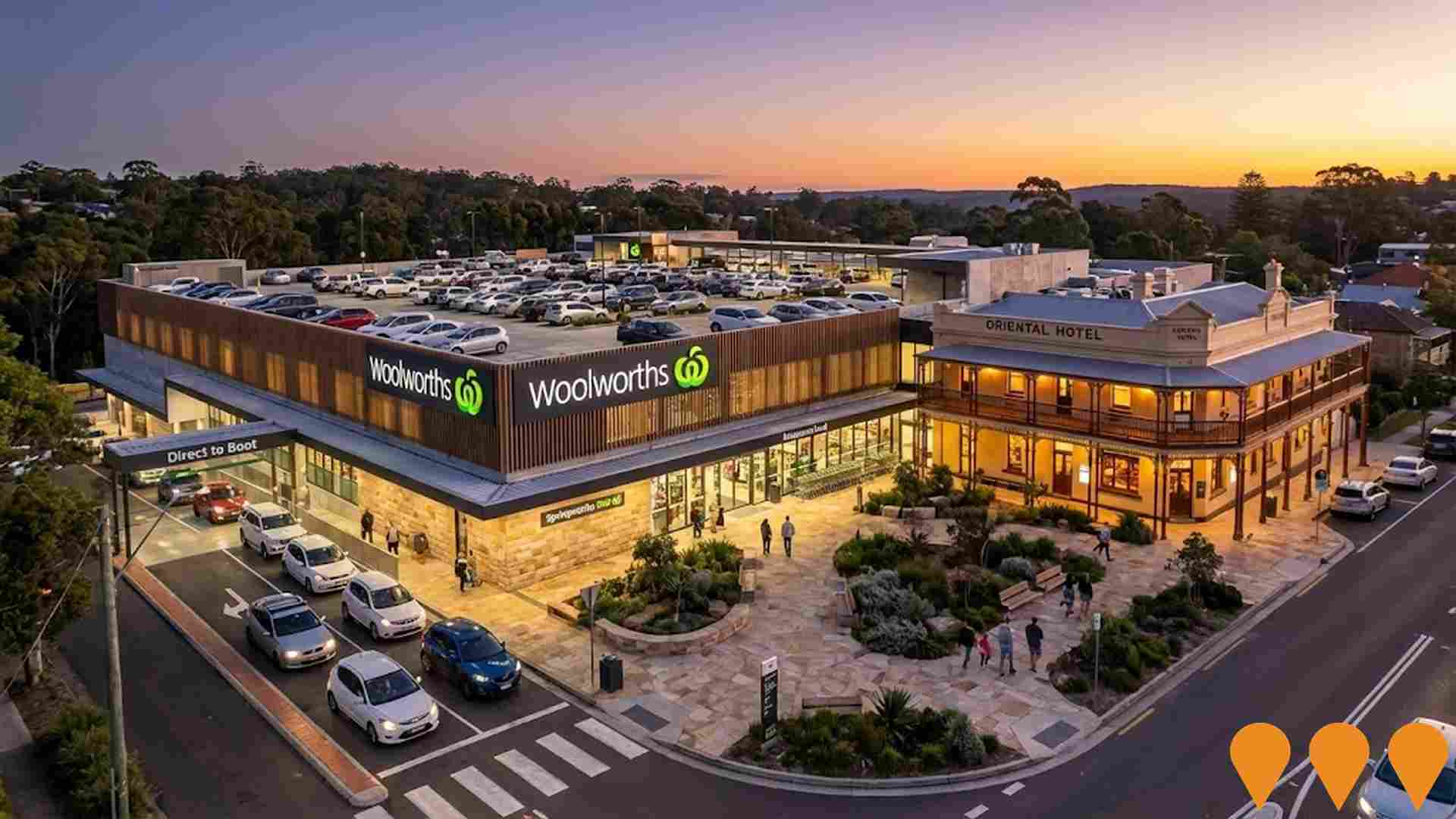
Springwood District Library Redevelopment
Redevelopment and expansion of Springwood Library into a modern, light filled district library with full height glazing to the south facade, new reading and study areas, meeting rooms, an accessible lift and an upgraded customer service area within the Springwood community and cultural precinct.
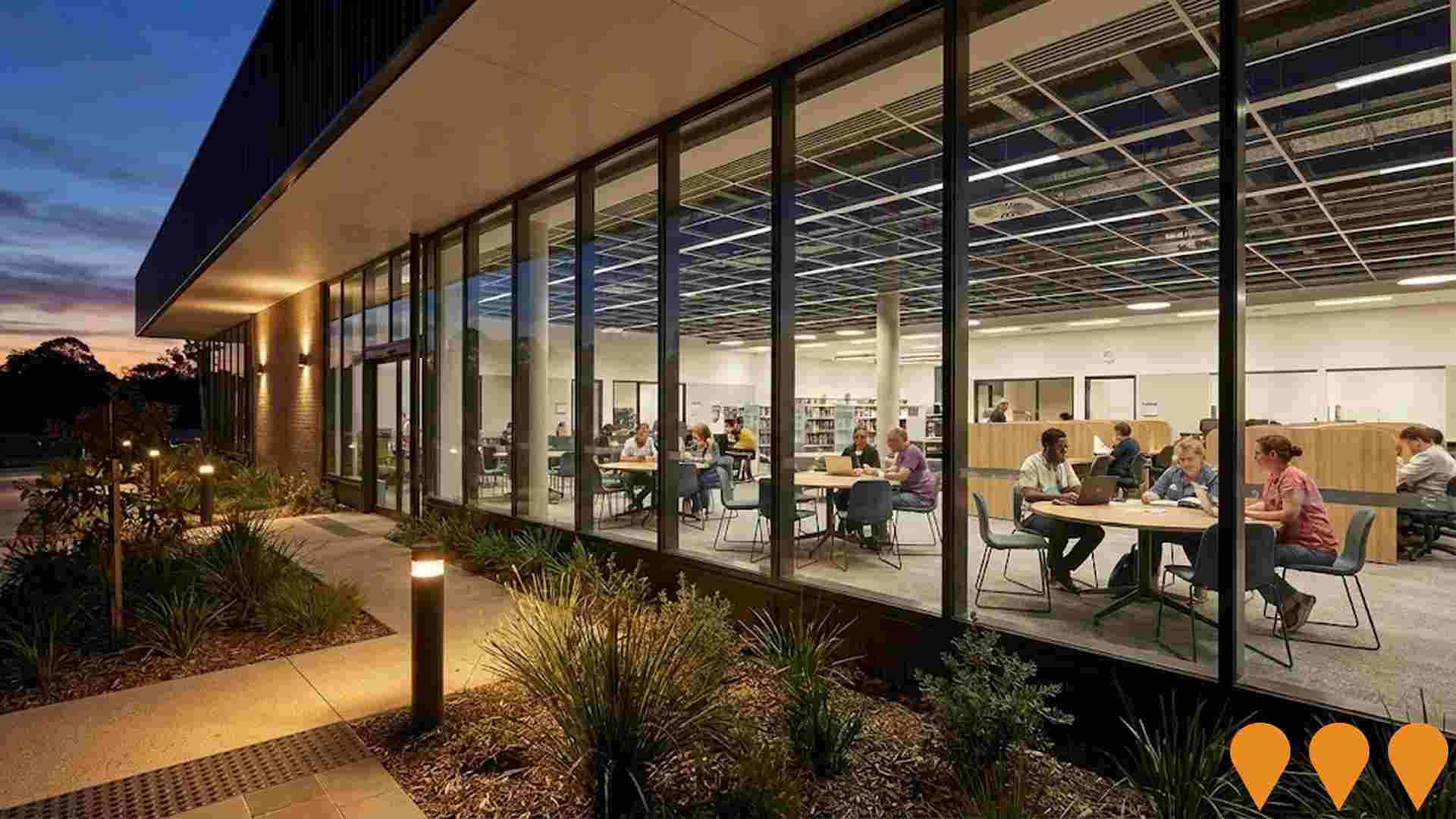
Rail Infrastructure Upgrades - Springwood Station
Upgrades and modifications to rail infrastructure at Springwood Station as part of Transport for NSWs Rail Infrastructure Upgrades program supporting the Mariyung and Regional Rail fleets. Works have included cable route installation within the station precinct, platform and track adjustments, and associated signalling and infrastructure changes along the Springwood to Lithgow corridor so the wider Mariyung intercity trains can operate safely on the Blue Mountains Line.

Springwood Town Centre Rejuvenation
Street and public domain upgrade delivering elements of the Springwood Town Centre Masterplan along Macquarie Road. Works funded through the Western Parkland City Liveability Program under the Western Sydney City Deal upgraded three key pedestrian crossings, formalised parking, renewed guttering and garden beds, and added new planting and seating to create a safer and more attractive high street that supports local businesses. Construction commenced in late 2020 and was completed in 2021, improving access to the railway station, shops and community facilities in the town centre.
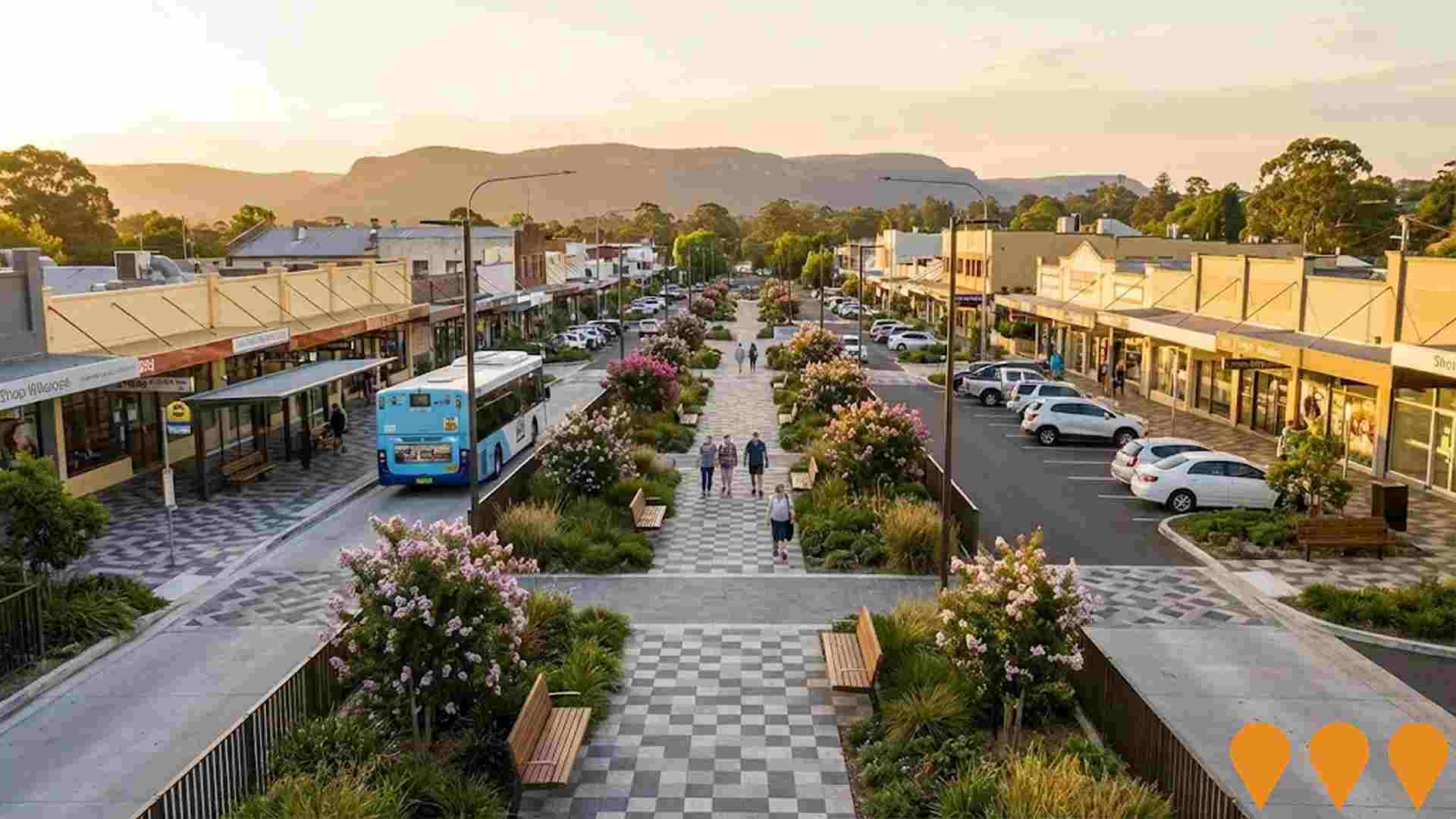
M12 Motorway - Western Package (M12 West)
The Western Package (M12 West) delivers about 6.1 km of the new M12 Motorway between The Northern Road at Luddenham and east of Badgerys Creek. Scope includes 11 bridges, a grade-separated interchange providing access to Western Sydney International Airport, a dual-carriageway four-lane airport access road, and a shared path. As of August 2025 the project is reported to be over 90% complete, with completion targeted for late 2025.

Digital Western Parkland City
Program to deliver digital infrastructure, data sharing and smart technology foundations across the Western Parkland City under the Western Sydney City Deal. Focus areas include shared data platforms, connectivity (including preparation for 5G trials), cybersecurity uplift, and city-scale smart solutions to improve services, sustainability and liveability.
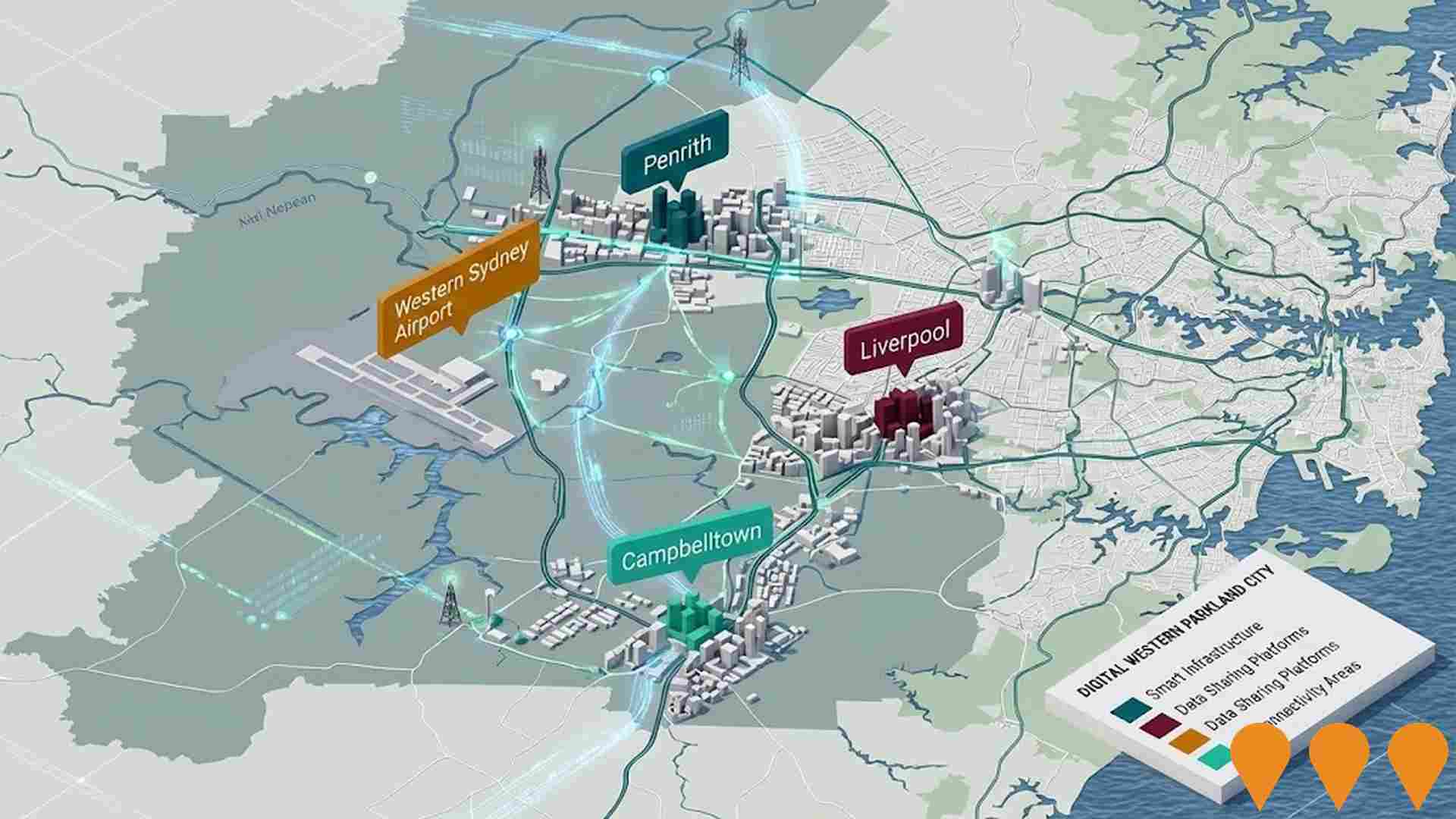
Employment
AreaSearch analysis reveals Springwood - Winmalee significantly outperforming the majority of regions assessed nationwide
Springwood - Winmalee has a well-educated workforce with essential services sectors being well represented. As of June 2025, the unemployment rate is 1.6%.
There are 12,168 residents in work, which is 2.6% below Greater Sydney's rate of 4.2%, while workforce participation is broadly similar at 60.0%. Leading employment industries include education & training, health care & social assistance, and construction. Education & training has a particularly high employment share, at 1.8 times the regional level, while professional & technical employs just 6.4% of local workers compared to Greater Sydney's 11.5%. The area may offer limited local employment opportunities, as indicated by the difference between Census working population and resident population figures.
Over the year ending June 2025, labour force levels decreased by 2.3%, alongside a 2.2% employment decline, with unemployment remaining essentially unchanged. In contrast, Greater Sydney recorded employment growth of 2.6%. Jobs and Skills Australia's national employment forecasts from May 2025 suggest that Springwood - Winmalee could see local employment growth of approximately 6.6% over five years and 13.7% over ten years.
Frequently Asked Questions - Employment
Income
The area exhibits notably strong income performance, ranking higher than 70% of areas assessed nationally through AreaSearch analysis
AreaSearch aggregated latest postcode level ATO data released for financial year 2022. Springwood - Winmalee had a median income among taxpayers of $57,844 and an average level of $70,641. These figures are above the national average. In Greater Sydney, the median was $56,994 and the average was $80,856. Based on Wage Price Index growth of 12.61% since financial year 2022, current estimates for Springwood - Winmalee are approximately $65,138 (median) and $79,549 (average) as of September 2025. According to Census 2021 income data, household, family and personal incomes in Springwood - Winmalee cluster around the 67th percentile nationally. Income brackets indicate that 33.1% earn $1,500 - 2,999 weekly (7,342 residents). This pattern is similar to the broader area where 30.9% occupy this income range. Housing accounts for 14.0% of income. Strong earnings rank residents within the 72nd percentile for disposable income. The area's SEIFA income ranking places it in the 7th decile.
Frequently Asked Questions - Income
Housing
Springwood - Winmalee is characterized by a predominantly suburban housing profile, with ownership patterns similar to the broader region
Springwood-Winmalee had 91.6% houses and 8.4% other dwellings in the latest Census, compared to Sydney metro's 92.3% houses and 7.7% other dwellings. Home ownership was 40.3%, with mortgaged dwellings at 45.5% and rented ones at 14.1%. The median monthly mortgage repayment was $2,167, higher than Sydney metro's $2,033. Median weekly rent was $420, compared to Sydney metro's $400. Nationally, Springwood-Winmalee's mortgage repayments were significantly higher at $2,167 versus the Australian average of $1,863, and rents were substantially above the national figure of $375.
Frequently Asked Questions - Housing
Household Composition
Springwood - Winmalee has a typical household mix, with a higher-than-average median household size
Family households constitute 76.5% of all households, including 35.6% couples with children, 30.4% couples without children, and 10.1% single parent families. Non-family households account for the remaining 23.5%, with lone person households at 22.0% and group households comprising 1.4%. The median household size is 2.6 people, larger than the Greater Sydney average of 2.4.
Frequently Asked Questions - Households
Local Schools & Education
Springwood - Winmalee shows strong educational performance, ranking in the upper quartile nationally when assessed across multiple qualification and achievement indicators
The area's educational profile is notable within its region, with university qualification rates at 32.1% for residents aged 15+, surpassing the SA4 region average of 23.9%. Bachelor degrees are most prevalent at 19.8%, followed by postgraduate qualifications (8.4%) and graduate diplomas (3.9%). Vocational credentials are also prominent, with 37.8% of residents aged 15+ holding such qualifications – advanced diplomas comprise 12.9% and certificates make up 24.9%.
Educational participation is high, with 28.5% of residents currently enrolled in formal education, including 9.7% in primary, 8.4% in secondary, and 4.4% in tertiary education. Eleven schools serve a total of 4,109 students, with the area demonstrating above-average socio-educational conditions (ICSEA: 1059). Education provision is balanced, with seven primary and four secondary schools serving distinct age groups. School capacity exceeds typical residential needs, at 18.5 places per 100 residents compared to the regional average of 14.5, indicating the area serves as an educational hub for the broader region. Note: where schools show 'n/a' for enrolments, please refer to the parent campus.
Frequently Asked Questions - Education
Schools Detail
Nearby Services & Amenities
Transport
Transport servicing is moderate compared to other areas nationally based on assessment of service frequency, route connectivity and accessibility
The analysis of public transport in Springwood-Winmalee shows that there are currently 225 active transport stops operating. These include a mix of train and bus services. The area is served by 106 individual routes which collectively facilitate 2,093 weekly passenger trips.
Transport accessibility is rated as good, with residents on average being located approximately 216 meters away from the nearest transport stop. On average, there are 299 trips per day across all routes, equating to around 9 weekly trips per individual stop.
Frequently Asked Questions - Transport
Transport Stops Detail
Health
Health performance in Springwood - Winmalee is lower than average with common health conditions somewhat prevalent across both younger and older age cohorts
Springwood-Winmalee faces significant health challenges, with common health conditions prevalent across both younger and older age cohorts.
The rate of private health cover is high at approximately 55% of the total population (~12,200 people). Mental health issues are the most common medical condition in the area, impacting 9.7% of residents, followed by arthritis affecting 9.1%. A total of 64.3% of residents declare themselves completely clear of medical ailments, compared to 64.1% across Greater Sydney. The area has 22.1% of residents aged 65 and over (4,909 people), lower than the 24.3% in Greater Sydney. Health outcomes among seniors present some challenges, broadly in line with the general population's health profile.
Frequently Asked Questions - Health
Cultural Diversity
Springwood - Winmalee ranks below the Australian average when compared to other local markets across a number of language and cultural background related metrics
Springwood-Winmalee has a lower-than-average cultural diversity, with 84.6% of its population born in Australia and 94.0% being citizens. English is the primary language spoken at home by 94.8%. Christianity is the predominant religion, practiced by 53.0%, compared to 47.1% across Greater Sydney.
The top three ancestral groups are English (30.5%), Australian (27.9%), and Irish (10.4%). Notably, Hungarian (0.4%) and Maltese (1.0%) populations are higher than the regional averages of 0.5% and 0.8%, respectively, while Welsh remains at the same level as the region (0.7%).
Frequently Asked Questions - Diversity
Age
Springwood - Winmalee hosts an older demographic, ranking in the top quartile nationwide
The median age in Springwood-Winmalee is 43 years, significantly higher than Greater Sydney's average of 37 and the national average of 38. The age profile shows that those aged 65-74 make up 11.5%, while those aged 25-34 comprise only 7.9%. Between 2021 and present, the 75 to 84 age group has increased from 6.2% to 7.7%, and the 15 to 24 cohort has risen from 11.1% to 12.4%. Conversely, the 25 to 34 cohort has decreased from 9.2% to 7.9%. By 2041, demographic projections indicate that the 85+ age group will grow by 813 people (129%), from 632 to 1,446. The combined 65+ age groups are projected to account for all total population growth, reflecting the area's aging demographic profile. Meanwhile, the 45 to 54 and 65 to 74 cohorts are expected to experience population declines.



